Integrated Assessment of the Land Use Change and Climate Change Impact on Baseflow by Using Hydrologic Model
Abstract
:1. Introduction
2. Methods
- Scenario 1 (S1: Baseline): 1990 land use and CC1 climate data (1990–2004).
- Scenario 2 (S2: Land-use change): 2018 land use and CC1 climate data (1990–2004).
- Scenario 3 (S3: Climate change): 1990 land use and CC2 climate data (2005–2019).
- Scenario 4 (S4: Climate change and land use change): 2018 land use and CC2 climate data (2005–2019).
2.1. Site Description
2.2. Data Description
2.3. Description of SWAT and SWAT-CUP
2.4. Estimation of Alpha Factor and SWAT Calibration Using the Estimated Alpha Factor
2.5. Baseflow Estimation Using the BFLOW Program
2.6. Evaluation of Streamflow and Baseflow Estimation from Scenarios
3. Results and Discussion
3.1. Calibration and Validation Results of SWAT Consider to Recession Curve
3.2. Change in Streamflow and Baseflow according to Land Use Climate Change Scenarios
4. Conclusions
- (1)
- In this study, Lee et al. [38] as the method proposed, the predictability of the base flow and low flow intervals is improved by considering the characteristics of the reducing section. Through these results, the variability of runoff and base runoff due to land use and climate change was analyzed. When analyzing using the SWAT model in various studies in the future, it is judged to be more effective only when flow rate and base flow rate analysis are performed after considering the characteristics of the reducing part.
- (2)
- In the case of Scenario 2, the impervious urban area increased, and the agricultural area, the permeability area, decreased. Compared to the baseline (Scenario 1), the total streamflow increased while the baseflow decreased. According to the hydrologic variation research results, land-use change with an increase in significant urbanization and a gradual decrease in agriculture and paddy area. Scenario 4, which analyzed both climate change and land-use change, showed similar trends in streamflow fluctuation to Scenario 3, which considered only climate change.
- (3)
- According to the results of the monthly streamflow and baseflow analysis, in Scenario 2, streamflow increased due to increased precipitation in summer, and baseflow decreased due to an increase in impervious area. Also, the amount of streamflow showed a tendency to decrease in the fall/winter season. Compared to the baseline in Scenario 1, Scenarios 3–4 showed large flow fluctuations in February and March, and then the baseflow was delayed with large fluctuations in March and April. The baseflow lag time is due to the study area’s steep slope topographical factors and soil properties.
- (4)
- It finds study area is vulnerable to both changes due to rapid population growth, precipitation changes due to climate change, land covers, and land-use change. Based on this study, findings will provide practical suggestions for environmental researchers and hydrology researchers on how to retain water resources more efficiently concerning its variability as a response to climate change and land use. The outcomes of this study can be used in quantifying the potential impacts of future projected climate change and land use change. Therefore, more studies need to evaluate this potential future impact on the hydrological system, with an emphasis on the interactive effect of environmental change drivers when predicting future change.
Author Contributions
Funding
Institutional Review Board Statement
Informed Consent Statement
Data Availability Statement
Conflicts of Interest
References
- Ferguson, G.; Gleeson, T. Vulnerability of coastal aquifers to groundwater use and climate change. Nat. Clim. Chang. 2012, 2, 342–345. [Google Scholar] [CrossRef]
- Lee, J.; Lee, S.; Hong, J.; Lee, D.; Bae, J.H.; Yang, J.E.; Kim, J.; Lim, K.J. Evaluation of rainfall erosivity factor estimation using machine and deep learning models. Water 2021, 13, 382. [Google Scholar] [CrossRef]
- Li, R.; Merchant, J.W. Modeling vulnerability of groundwater to pollution under future scenarios of climate change and biofuels-related land use change: A case study in North Dakota, USA. J. Sci. Total Environ. 2013, 447, 32–45. [Google Scholar] [CrossRef]
- Lee, J.; Kim, J.; Lee, J.M.; Jang, H.S.; Park, M.; Min, J.H.; Na, E.H. Analyzing the Impacts of Sewer Type and Spatial Distribution of LID Facilities on Urban Runoff and Non-Point Source Pollution Using the Storm Water Management Model (SWMM). Water 2022, 14, 2776. [Google Scholar] [CrossRef]
- Haddelanda, I.; Heinkeb, J.; Biemansd, H.; Eisnere, S.; Florkee, M.; Hanasakif, N.; Konzmannb, M.; Ludwigd, F.; Masakif, Y.; Scheweb, J.; et al. Global water resources affected by human interventions and climate change. Proc. Natl. Acad. Sci. USA 2014, 111, 3251–3256. [Google Scholar] [CrossRef]
- George, Z.N.; Woyessa, Y. Evaluation of streamflow under climate change in the Zambezi River basin of Southern Africa. Water 2021, 13, 3114–3134. [Google Scholar]
- Lee, J.; Ryu, J.C.; Kang, H.W.; Kum, D.H.; Jang, C.H.; Choi, J.D.; Lim, K.J. Evaluation of SWAT flow and sediment estimation and effects of soil erosion best management practices. J. Korean Soc. Agric. Eng. 2012, 54, 99–108. [Google Scholar] [CrossRef]
- Lee, J.; Shin, Y.; Park, Y.S.; Kum, D.; Lim, K.J.; Lee, S.O.; Kim, H.; Jung, Y. Estimation and assessment of baseflow at an ungauged watershed according to landuse change. J. Wetl. Res. 2014, 16, 303–318. [Google Scholar]
- Shuster, W.D.; Bonta, J.; Thurston, H.; Warnemuende, E.; Smith, D.R. Impacts of impervious surface on watershed hydrology: A review. J. Urban Water 2005, 2, 263–275. [Google Scholar] [CrossRef]
- Ogden, F.L.; Raj, P.N.; Downer, C.W.; Zahner, J.A. Relative importance of impervious area, drainage density, width function, and subsurface storm drainage on flood runoff from an urbanized catchment. J. Water Resour. Res. 2011, 47, 1–12. [Google Scholar] [CrossRef]
- Kim, S.J.; Kwon, H.J.; Park, G.; Lee, M.S. Assessment of land-use impact on streamflow via a grid-based modelling approach including paddy fields. J. Hydrol. Process. 2005, 19, 3801–3817. [Google Scholar] [CrossRef]
- Gao, Y.Z.; Giese, M.; Han, X.G.; Wang, D.L.; Zhou, Z.Y.; Brueck, H.; Lin, S.; Taube, F. Land use and drought interactively affect interspecific competition and species diversity at the local scale in a semiarid steppe ecosystem. J. Ecol. Res. 2009, 24, 627–635. [Google Scholar] [CrossRef]
- Maneta, M.P.; Torres, M.D.O.; Wallender, W.W.; Vosti, S.; Howitt, R.; Rodrigues, L.; Bassoi, L.H.; Panday, S. A spatially distributed hydro economic model to assess the effects of drought on land use, farm profits, and agricultural employment. J. Water Resour. Res. 2009, 45, W11412. [Google Scholar] [CrossRef]
- De Moel, H.; Aerts, J.C.J.H. Effect of uncertainty in land use, damage models and inundation depth on flood damage estimates. J. Nat. Hazards 2011, 58, 407–425. [Google Scholar] [CrossRef]
- Wheater, H.S.; Ballard, C.; Bulygina, N.; McIntyre, N.; Jackson, B.M. Modelling Environmental Change: Quantification of Impacts of Land Use and Land Management Change on UK Flood Risk. J. Syst. Identif. Environ. Model. Control Syst. Des. 2012, 22, 449–481. [Google Scholar]
- Hamel, P.; Daly, E.; Fletcher, T.D. Source-control stormwater management for mitigating the impacts of urbanization on baseflow: A review. J. Hydrol. 2013, 485, 201–211. [Google Scholar] [CrossRef]
- Malhi, Y.; Aragão, L.E.; Galbraith, D.; Huntingford, C.; Fisher, R.; Zelazowski, P.; Sitch, S.; Mc Sweeney, C.; Meir, P. Exploring the likelihood and mechanism of a climate-change-induced dieback of the Amazon rainforest. Proc. Natl. Acad. Sci. USA 2009, 106, 20610–20615. [Google Scholar] [CrossRef] [PubMed]
- Wang, L.; Lyons, J.; Kanehl, P.; Bannerman, R. Impacts of urbanization on stream habitat and fish across multiple spatial scales. J. Environ. Manag. 2001, 28, 255–266. [Google Scholar] [CrossRef]
- Price, K. Effects of watershed topography, soils, land use, and climate on baseflow hydrology in humid regions: A review. J. Geogr. Phys. 2011, 35, 465–492. [Google Scholar] [CrossRef]
- Hall, F.R. Base-Flow Recessions-A Review. J. Water Resour. Res. 1968, 4, 973–983. [Google Scholar] [CrossRef]
- Sophocleous, M. Interactions between groundwater and surface water: The state of the science. J. Hydrogeol. 2002, 10, 52–67. [Google Scholar] [CrossRef]
- Santhi, C.; Allen, P.M.; Muttiah, R.S.; Arnold, J.G.; Tuppad, P. Regional estimation of base flow for the conterminous United States by hydrologic landscape regions. J. Hydrol. 2008, 351, 139–153. [Google Scholar] [CrossRef]
- Ward, R.C.; Robinson, M. McGraw-Hill International UK Limited, UK. J. Princ. Hydrol. 1990, 365. [Google Scholar]
- Lee, J.; Park, Y.S.; Jung, Y.; Cho, J.; Yang, J.E.; Lee, G.; Kim, K.S.; Lim, K.J. Analysis of spatiotemporal changes in groundwater recharge and baseflow using SWAT and BFlow Models. J. Korean Soc. Water Environ. 2014, 30, 549–558. [Google Scholar] [CrossRef]
- Avesani, D.; Galletti, A.; Piccolroaz, S.; Bellin, A.; Majone, B. A dual-layer MPI continuous large-scale hydrological model including Human Systems. Environ. Model. Softw. 2021, 139, 105003. [Google Scholar] [CrossRef]
- Nathan, R.J.; McMahon, T.A. Evaluation of automated techniques for base flow and recession analyses. J. Water Resour. Res. 1990, 26, 1465–1473. [Google Scholar] [CrossRef]
- Tallaksen, L.M. A review of baseflow recession analysis. J. Hydrol. 1995, 165, 349–370. [Google Scholar] [CrossRef]
- Szilagyi, J.; Parlange, M.B. Baseflow separation based on analytical solutions of the Boussinesq equation. J. Hydrol. 1998, 204, 251–260. [Google Scholar] [CrossRef]
- Arnold, J.G.; Allen, P.M. Validation of Automated Methods for Estimating Baseflow and Groundwater Recharge from Stream Flow Records. J. Am. Water Resour. Assoc. 1999, 35, 411–424. [Google Scholar] [CrossRef]
- Ahiablame, L.; Chaubey, I.; Engel, B.; Cherkauer, K.; Merwade, V. Estimation of annual baseflow at ungauged sites in Indiana USA. J. Hydrol. 2013, 476, 13–27. [Google Scholar] [CrossRef]
- Bako, M.D.; Owoade, A. Field application of a numerical method for the derivation of baseflow recession constant. J. Hydrol. Process. 1988, 2, 331–336. [Google Scholar] [CrossRef]
- Wilcox, B.P.; Huang, Y. Woody plant encroachment paradox: Rivers rebound as degraded grasslands convert to woodlands. J. Geophys. Res. Lett. 2010, 37. [Google Scholar] [CrossRef]
- Samuel, J.; Coulibaly, P.; Metcalfe, R.A. Identification of rainfall–runoff model for improved baseflow estimation in ungauged basins. J. Hydrol. Process. 2012, 26, 356–366. [Google Scholar] [CrossRef]
- Gitau, M.W.; Chaubey, I. Regionalization of SWAT model parameters for use in ungauged watersheds. J. Water 2010, 2, 849–871. [Google Scholar] [CrossRef]
- Singh, A.; Imtiyaz, M.; Isaac, R.K.; Denis, D.M. Comparison of soil and water assessment tool (SWAT) and multilayer perceptron (MLP) artificial neural network for predicting sediment yield in the Nagwa agricultural watershed in Jharkhand, India. J. Agric. Water Manag. 2012, 104, 113–120. [Google Scholar] [CrossRef]
- Eckhardt, K. How to construct recursive digital filters for baseflow separation. J. Hydrol. Process. 2005, 19, 507–515. [Google Scholar] [CrossRef]
- Eckhardt, K. A comparison of baseflow indices, which were calculated with seven different baseflow separation methods. J. Hydrol. 2008, 352, 168–173. [Google Scholar] [CrossRef]
- Lee, J.; Kim, J.; Jang, W.S.; Lim, K.J.; Engel, B. Assessment of Baseflow estimates considering recession characteristics in SWAT. Water 2018, 10, 371–385. [Google Scholar] [CrossRef]
- Chaplot, V. Impact of DEM mesh size and soil map scale on SWAT runoff, sediment, and NO3–N loads predictions. J. Hydrol. 2005, 312, 207–222. [Google Scholar] [CrossRef]
- Jeong, J.; Kannan, N.; Arnold, J.; Glick, R.; Gosselink, L.; Srinivasan, R.; Harmel, D. Development of Sub Daily Erosion and Sediment Transport Models in SWAT. Trans. ASABE 2011, 54, 1685–1691. [Google Scholar] [CrossRef]
- Neitsch, S.L.; Arnold, J.G.; Kiniry, J.R.; Williams, J.R.; King, K.W. Soil and Water Assessment Tool: Theoretical Documentation, Version 2005; Texas Water Resources Institute: College Station, TX, USA, 2005. [Google Scholar]
- Arnold, J.G.; Allen, P.M.; Bernhardt, G. A comprehensive surface-groundwater flow model. J. Hydrol. 1993, 142, 47–69. [Google Scholar] [CrossRef]
- Abbaspour, K.C.; Yang, J.; Maximov, I.; Siber, R.; Bonger, K.; Mieleitner, J.; Zobrist, J.; Srinivasan, R. Modelling Hydrology and Water Quality in the Pre-alpine Thur Watershed using SWAT. J. Hydrol. 2007, 333, 413–430. [Google Scholar] [CrossRef]
- Beven, K.J.; Binley, A.M. The future of distributed models: Model calibration and uncertainty prediction. J. Hydrol. Process. 1992, 6, 279–298. [Google Scholar] [CrossRef]
- Van Griensven, A.; Meixner, T. Methods to quantify and identify the sources of uncertainty for river basin water quality models. J. Water Sci. Technol. 2006, 53, 51–59. [Google Scholar] [CrossRef] [PubMed]
- Kuczera, G.; Parent, E. Monte Carlo assessment of parameter uncertainty in conceptual catchment models: The Metropolis algorithm. J. Hydrol. 1998, 211, 69–85. [Google Scholar] [CrossRef]
- Eberhart, R.; Kennedy, J. A new optimizer using particle swarm theory. In Proceedings of the Sixth International Symposium on Micro Machine and Human Science, MHS’95, Nagoya, Japan, 4–6 October 1995; pp. 39–43. [Google Scholar]
- Rostamian, R.; Jaleh, A.; Afyuni, M.; Mousavi, S.F.; Heidarpour, M.; Jalalian, A.; Abbaspour, K.C. Application of a SWAT model for estimating runoff and sediment in two mountainous basins in central Iran. J. Hydrol. Sci. 2008, 53, 977–988. [Google Scholar] [CrossRef]
- Abbaspour, K.C. SWAT-CUP4: SWAT Calibration and Uncertainty Programs—A User Manual; EAWAG Swiss Federal Institute of Aquatic Science and Technology: Dubendorf, Switzerland, 2011; pp. 1–103. [Google Scholar]
- Leta, O.T.; El-kadi, A.I.; Dulai, H.; Ghazal, K.A. Assessment of climate change impacts on water balance components of Heeia watershed in Hawaii. J. Hydrol. Reg. Stud. 2016, 8, 182–197. [Google Scholar] [CrossRef]
- Arnold, J.G.; Allen, P.M.; Muttiah, R.; Bernhardt, G. Automated baseflow separation and recession analysis techniques. Groundwater 1995, 33, 1010–1018. [Google Scholar] [CrossRef]
- Ahiablame, L.; Engel, B.; Chaubey, I. Representation and evaluation of low impact development practices with L-THIA-LID: An example for planning. Environ. Pollut. 2012, 1, 1. [Google Scholar] [CrossRef]
- Moriasi, D.N.; Arnold, J.G.; Van Liew, M.W.; Bingner, R.L.; Harmel, R.D.; Veith, T.L. Model evaluation buidelines for systematic quantification of accuracy in watershed simulations. Am. Soc. Agric. Biol. Eng. 2007, 50, 885–900. [Google Scholar]
- Singh, J.; Knapp, H.V.; Arnold, J.G.; Demissie, M. Hydrologic modeling of the Iroquois river watershed using HSPF and SWAT. J. Am. Water Resour. Assoc. 2005, 41, 361–375. [Google Scholar] [CrossRef]
- Jang, W.S.; Engel, B.; Ryu, J. Efficient flow calibration method for accurate estimation of baseflow using a watershed scale hydrological model (SWAT). Ecol. Eng. 2018, 125, 50–67. [Google Scholar] [CrossRef]
- Izuka, S.K.; Hill, B.R.; Shade, P.J.; Tribble, G.W. Geohydrology and Possible Transport Routes of Polychlorinated Biphenyls in Haiku Valley, Oahu Hawaii; Water-Resources Investigations Report; USGS: Reston, VA, USA, 1993. [Google Scholar]
- Furey, P.R.; Gupta, V.K. A physically based filter for separating base flow from streamflow time series. Water Resour. Res. 2001, 37, 2709–2722. [Google Scholar] [CrossRef]
- Siddik, S.; Tulip, S.S.; Rahman, A.; Islam, N.; Haghighi, A.T.; Mustafa, S.M.T. The impact of land use and land cover change on groundwater recharge in northwestern Bangladesh. J. Environ. Manag. 2022, 315, 115130. [Google Scholar] [CrossRef] [PubMed]
- Mojid, M.A.; Mainuddin, M. Water-saving agricultural technologies: Regional hydrology outcomes and knowledge gaps in the eastern gangetic plains—A review. Water 2021, 13, 636. [Google Scholar] [CrossRef]
- Kim, H.-K.; Kang, M.-S.; Lee, E.-J.; Park, S.-W. Climate and Land Use Changes Impacts on Hydrology in a Rural Small Watershed. J. Korean Soc. Agric. Eng. 2011, 53, 75–84. [Google Scholar]
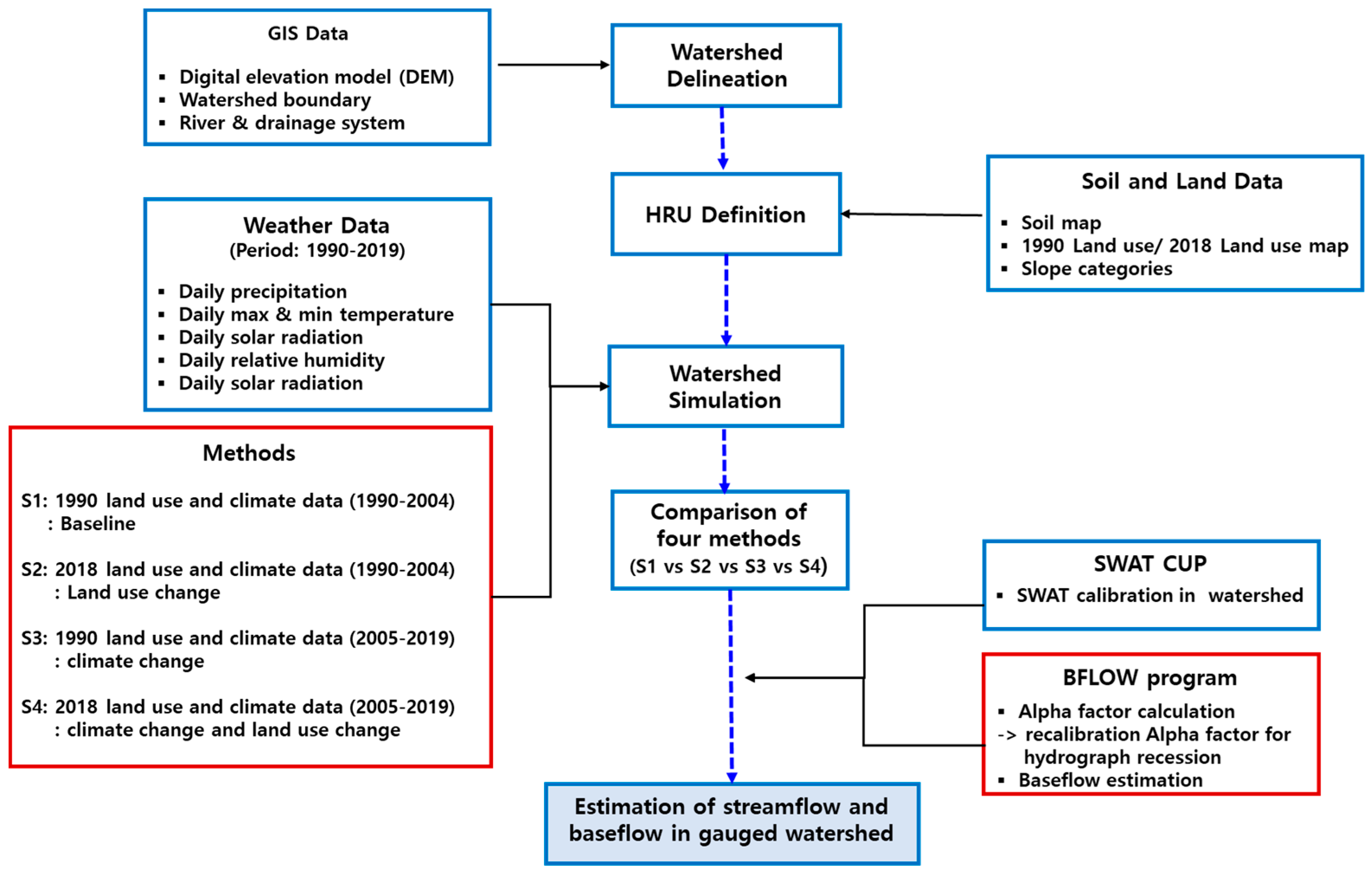





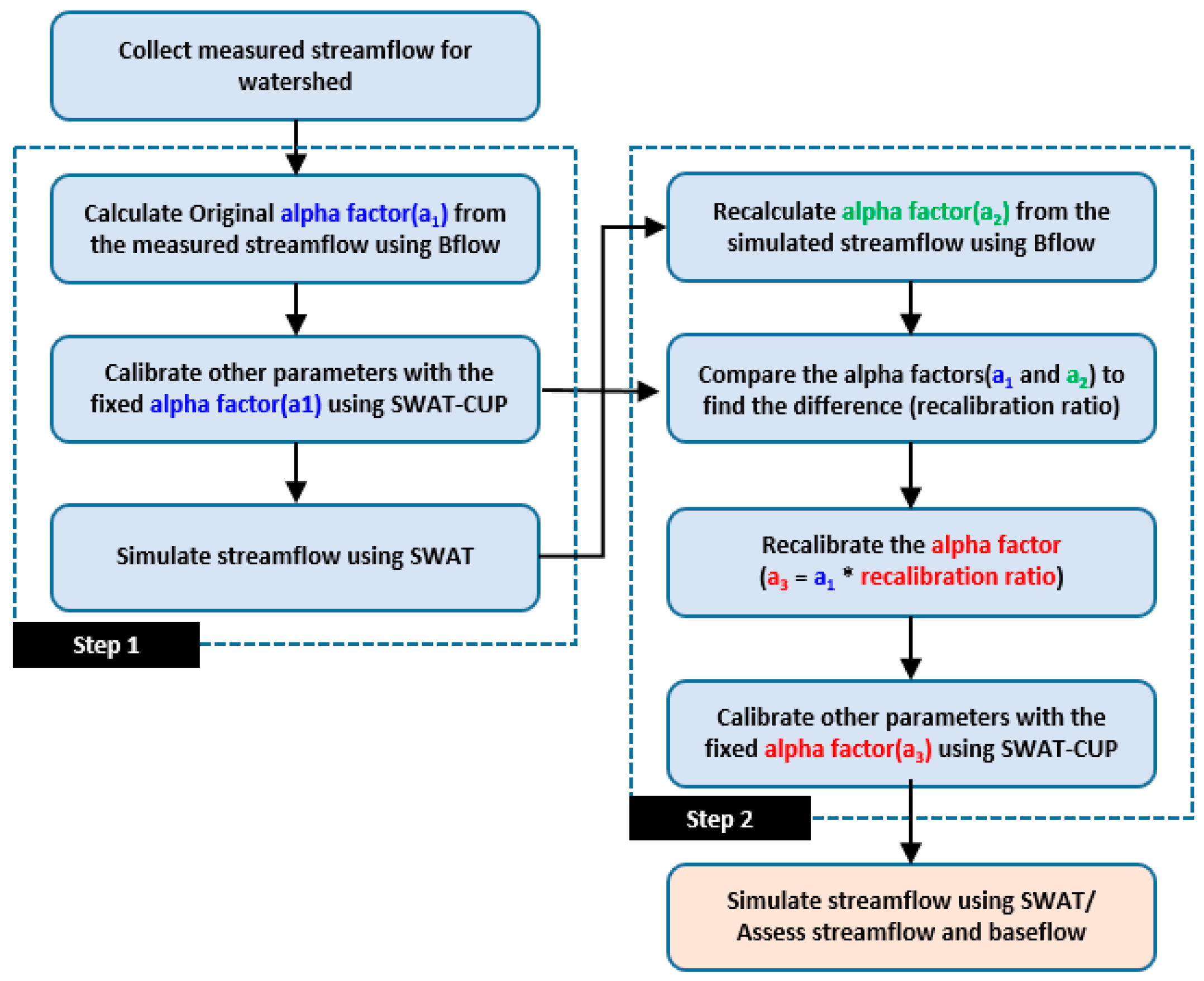
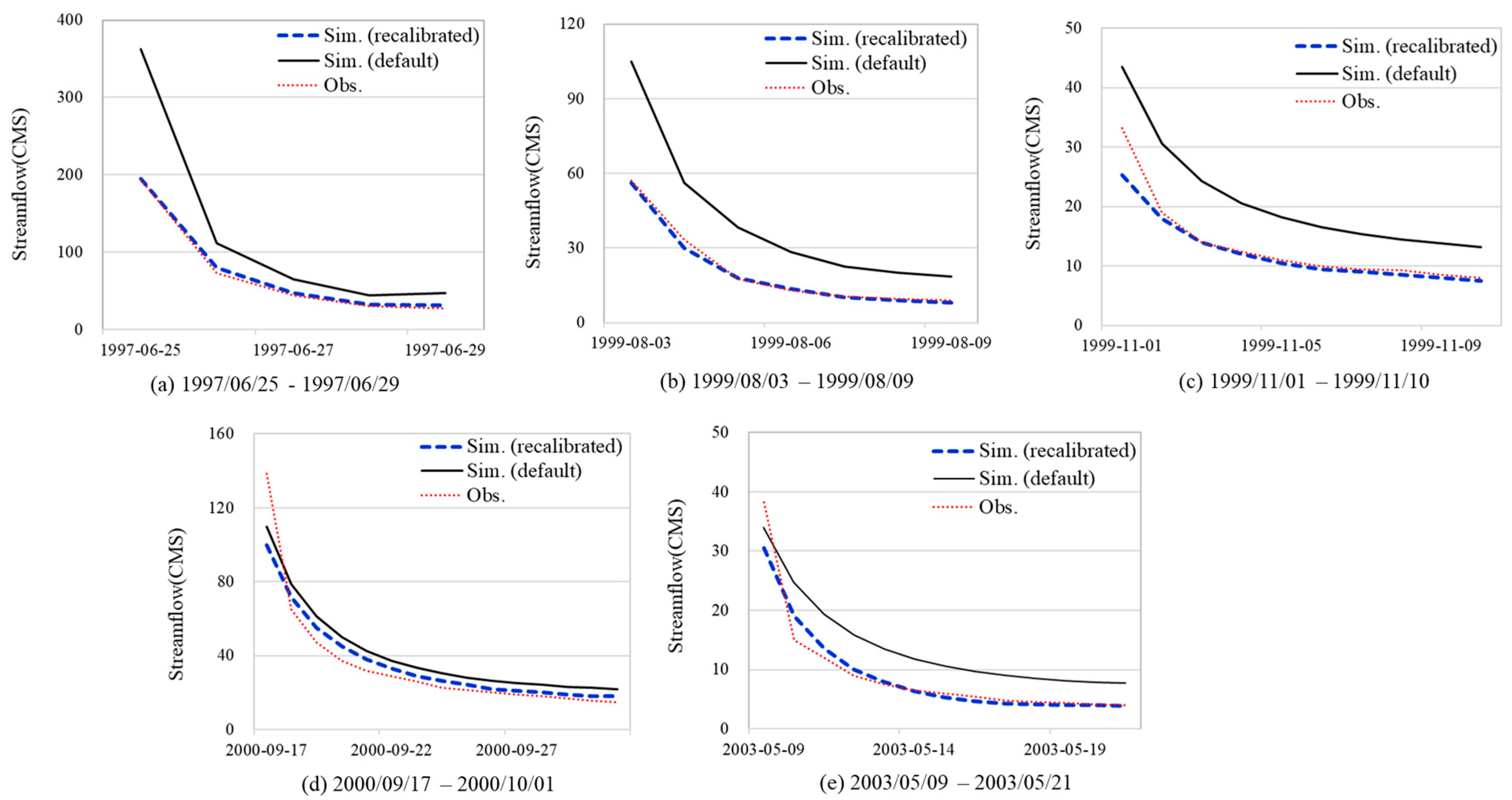
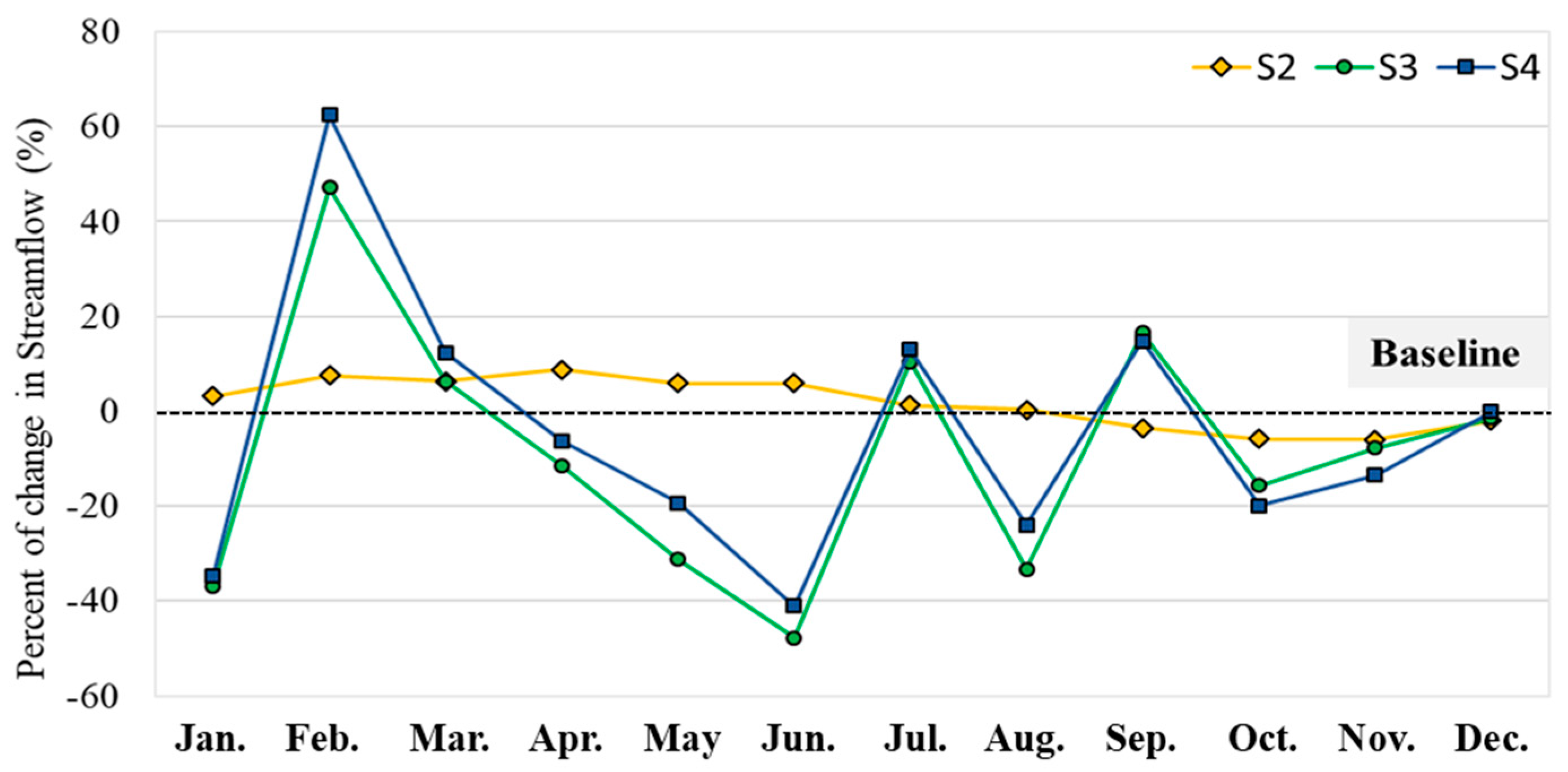
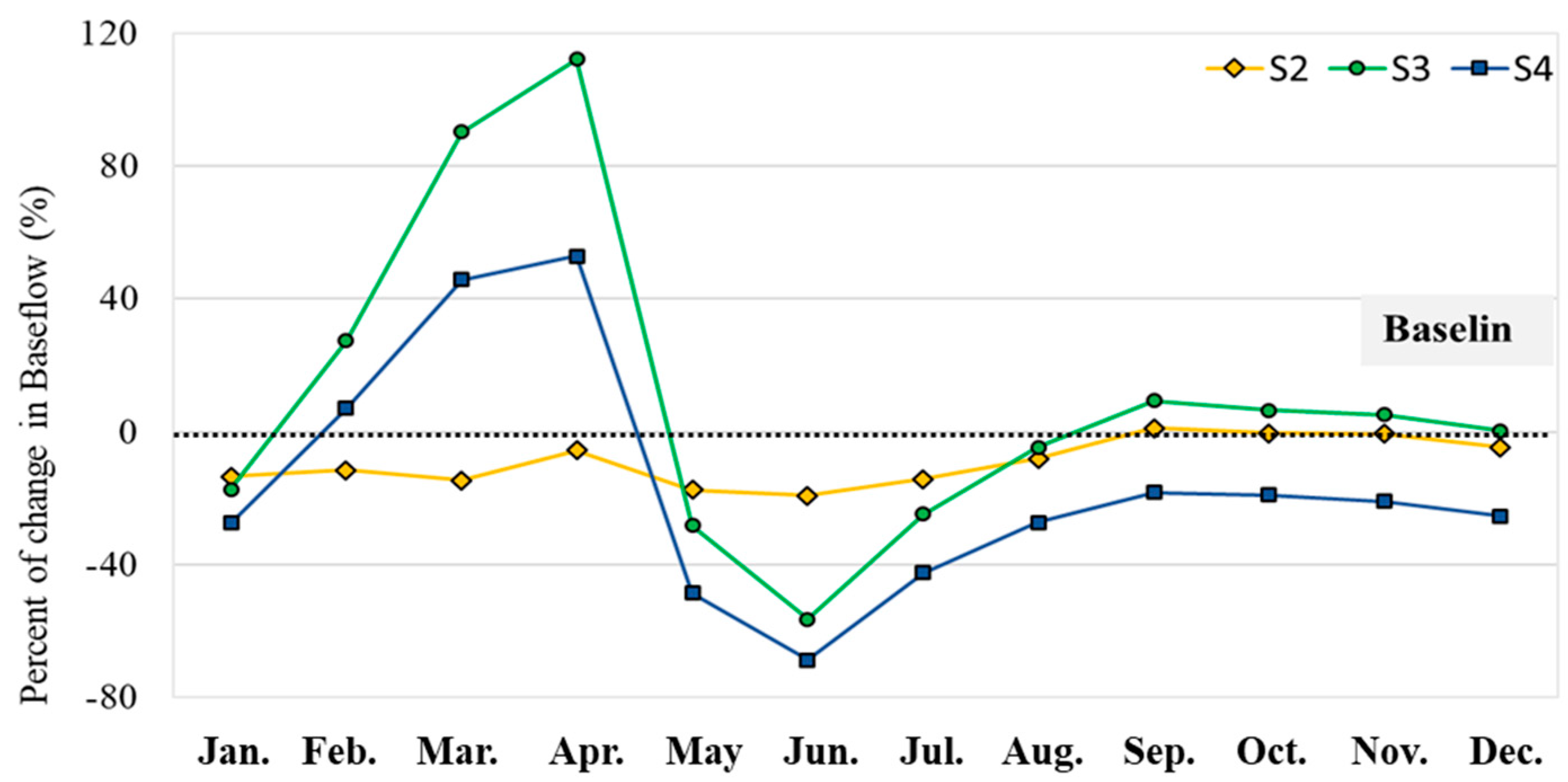
| Year | 1990 | 2018 | Temporal Change in Area (km2) | |||
|---|---|---|---|---|---|---|
| Land Use Type | Area (km2) | Percent (%) | Area (km2) | Percent (%) | ||
| Urbanization | 42.28 | 7.02 | 75.76 | 12.58 | 33.48 | |
| Agriculture | 91.30 | 15.16 | 56.07 | 9.31 | −35.23 | |
| Forest | 410.53 | 68.17 | 428.00 | 71.07 | 17.46 | |
| Pasture | 29.15 | 4.84 | 24.39 | 4.05 | −4.76 | |
| Water | 2.53 | 0.42 | 2.59 | 0.43 | 0.06 | |
| Paddy | 26.44 | 4.39 | 15.42 | 2.56 | −11.02 | |
| Total | 602.22 | 100.00 | 602.22 | 100.00 | 0.00 | |
| Data Type | Resolution | Periods | Source |
|---|---|---|---|
| Precipitation | Temporal (1 day) | 1990~2019 | KMA (Korea Meteorological Administration) |
| Temperature | Temporal (1 day) | 1990~2019 | KMA (Korea Meteorological Administration) |
| Wind Speed | Temporal (1 day) | 1990~2019 | KMA (Korea Meteorological Administration) |
| Solar Radiation | Temporal (1 day) | 1990~2019 | KMA (Korea Meteorological Administration) |
| Humidity | Temporal (1 day) | 1990~2019 | KMA (Korea Meteorological Administration) |
| DEM (Digital Elevation Model) | Spatial | - | NGII (National Geographic Information Institute) |
| Land use | Spatial | 1990, 2018 | EGIS (Environmental Geographic Information System) |
| Soil | Spatial | 2017 | RDA (Rural Development Administration) |
| Rank | Parameter Name | p-Value | t-Stat |
|---|---|---|---|
| 1 | CH_K2 | 0 | −23.36 |
| 2 | ALPHA_BF | 0 | 12.29 |
| 3 | SLSUBBSN | 0 | −2.80 |
| 4 | SURLAG | 0.02 | 2.35 |
| 5 | CN2 | 0.11 | 1.62 |
| 6 | SOL_K | 0.11 | 1.60 |
| 7 | HRU_SLP | 0.20 | −1.29 |
| 8 | CANMX | 0.20 | −1.28 |
| 9 | ESCO | 0.30 | −1.04 |
| 10 | SOL_AWC | 0.34 | −0.95 |
| 11 | EPCO | 0.45 | 0.76 |
| 12 | GWQMN | 0.82 | 0.22 |
| Period | Streamflow (m3/s) | Baseflow (m3/s) | ||||||||
|---|---|---|---|---|---|---|---|---|---|---|
| NSE | R2 | KGE | RMSE | MAE | NSE | R2 | KGE | RMSE | MAE | |
| Calibration (1994–2004) | 0.66 | 0.71 | 0.52 | 9.98 | 9.97 | 0.59 | 0.64 | 0.70 | 8.03 | 5.16 |
| Validation (2005–2008) | 0.70 | 0.75 | 0.63 | 6.60 | 6.61 | 0.73 | 0.75 | 0.78 | 5.85 | 3.29 |
| No. | Climate | Average Precipitation (mm) | Land Use | Streamflow (mm) | Surface Runoff (mm) | Baseflow (mm) | ||||||
|---|---|---|---|---|---|---|---|---|---|---|---|---|
| Average | Percent (%) | Change | Average | Percent (%) | Change | Average | Percent (%) | Change | ||||
| S1 | CC1 | 1398.2 (Max: 2070.0) (Min: 828.7) | 1990 | 705.6 | - | - | 578.8 | - | - | 126.8 | - | - |
| S2 | CC1 | 1398.2 (Max: 2070.0) (Min: 828.7) | 2018 | 725.5 | 2.8% | 19.9 | 620.8 | 7.3% | 42.0 | 104.7 | −17.4% | −22.1 |
| S3 | CC2 | 1296.5 (Max: 1943.4) (Min: 822.6) | 1990 | 629.8 | −10.7% | −75.8 | 515.2 | −11.0% | −63.6 | 114.6 | −9.6% | −12.2 |
| S4 | CC2 | 1296.5 (Max: 1943.4) (Min: 822.6) | 2018 | 649.4 | −8.0% | −56.2 | 555.8 | −4.0% | −23.0 | 93.6 | −26.2% | −33.2 |
| Year | Average Annual Precipitation | Average Annual Temperature | ||||
|---|---|---|---|---|---|---|
| Average (mm) | Maximum (mm) | Minimum (mm) | Median (mm) | Maximum (°C) | Minimum (°C) | |
| Year 1 (1990–2000) | 1381.3 | 2070.0 | 857.39 | 1455.2 | 34.8 | −13.5 |
| Year 2 (2001–2010) | 1360.3 | 1750.9 | 828.7 | 1399.2 | 33.8 | −13.6 |
| Year 3 (2011–2019) | 1255.2 | 1943.4 | 822.6 | 1127.5 | 36.4 | −13.8 |
Disclaimer/Publisher’s Note: The statements, opinions and data contained in all publications are solely those of the individual author(s) and contributor(s) and not of MDPI and/or the editor(s). MDPI and/or the editor(s) disclaim responsibility for any injury to people or property resulting from any ideas, methods, instructions or products referred to in the content. |
© 2023 by the authors. Licensee MDPI, Basel, Switzerland. This article is an open access article distributed under the terms and conditions of the Creative Commons Attribution (CC BY) license (https://creativecommons.org/licenses/by/4.0/).
Share and Cite
Lee, J.; Park, M.; Min, J.-H.; Na, E.H. Integrated Assessment of the Land Use Change and Climate Change Impact on Baseflow by Using Hydrologic Model. Sustainability 2023, 15, 12465. https://doi.org/10.3390/su151612465
Lee J, Park M, Min J-H, Na EH. Integrated Assessment of the Land Use Change and Climate Change Impact on Baseflow by Using Hydrologic Model. Sustainability. 2023; 15(16):12465. https://doi.org/10.3390/su151612465
Chicago/Turabian StyleLee, Jimin, Minji Park, Joong-Hyuk Min, and Eun Hye Na. 2023. "Integrated Assessment of the Land Use Change and Climate Change Impact on Baseflow by Using Hydrologic Model" Sustainability 15, no. 16: 12465. https://doi.org/10.3390/su151612465






